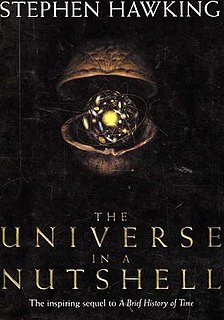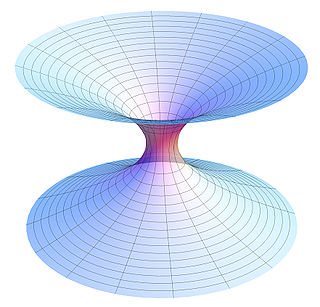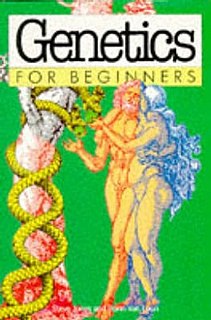
In physical cosmology, cosmic inflation, cosmological inflation, or just inflation, is a theory of exponential expansion of space in the early universe. The inflationary epoch lasted from 10−36 seconds after the conjectured Big Bang singularity to some time between 10−33 and 10−32 seconds after the singularity. Following the inflationary period, the universe continued to expand, but at a slower rate. The acceleration of this expansion due to dark energy began after the universe was already over 9 billion years old.

General relativity, also known as the general theory of relativity, is the geometric theory of gravitation published by Albert Einstein in 1915 and is the current description of gravitation in modern physics. General relativity generalizes special relativity and refines Newton's law of universal gravitation, providing a unified description of gravity as a geometric property of space and time or four-dimensional spacetime. In particular, the curvature of spacetime is directly related to the energy and momentum of whatever matter and radiation are present. The relation is specified by the Einstein field equations, a system of partial differential equations.

Sir Roger Penrose is an English mathematical physicist, mathematician, philosopher of science and Nobel Laureate in Physics. He is Emeritus Rouse Ball Professor of Mathematics at the University of Oxford, an emeritus fellow of Wadham College, Oxford and an honorary fellow of St John's College, Cambridge, and of University College London (UCL).

A theory of everything, final theory, ultimate theory, or master theory is a hypothetical single, all-encompassing, coherent theoretical framework of physics that fully explains and links together all physical aspects of the universe. Finding a TOE is one of the major unsolved problems in physics. String theory and M-theory have been proposed as theories of everything. Over the past few centuries, two theoretical frameworks have been developed that, together, most closely resemble a TOE. These two theories upon which all modern physics rests are general relativity and quantum mechanics. General relativity is a theoretical framework that only focuses on gravity for understanding the universe in regions of both large scale and high mass: stars, galaxies, clusters of galaxies, etc. On the other hand, quantum mechanics is a theoretical framework that only focuses on three non-gravitational forces for understanding the universe in regions of both small scale and low mass: sub-atomic particles, atoms, molecules, etc. Quantum mechanics successfully implemented the Standard Model that describes the three non-gravitational forces – strong nuclear, weak nuclear, and electromagnetic force – as well as all observed elementary particles.

A Brief History of Time: From the Big Bang to Black Holes is a popular-science book on cosmology by English physicist Stephen Hawking. It was first published in 1988. Hawking wrote the book for readers without prior knowledge of physics and people who are just interested in learning something new.

The Universe in a Nutshell is a 2001 book about theoretical physics by Stephen Hawking. It is generally considered a sequel and was created to update the public concerning developments since the multi-million-copy bestseller A Brief History of Time published in 1988.

Leonard Susskind is an American physicist, who is a professor of theoretical physics at Stanford University, and founding director of the Stanford Institute for Theoretical Physics. His research interests include string theory, quantum field theory, quantum statistical mechanics and quantum cosmology. He is a member of the US National Academy of Sciences, and the American Academy of Arts and Sciences, an associate member of the faculty of Canada's Perimeter Institute for Theoretical Physics, and a distinguished professor of the Korea Institute for Advanced Study.

Quantum cosmology is the attempt in theoretical physics to develop a quantum theory of the Universe. This approach attempts to answer open questions of classical physical cosmology, particularly those related to the first phases of the universe.

John R. Gribbin is a British science writer, an astrophysicist, and a visiting fellow in astronomy at the University of Sussex. His writings include quantum physics, human evolution, climate change, global warming, the origins of the universe, and biographies of famous scientists. He also writes science fiction.
Oscar Zárate is an Argentine comic book artist and illustrator. Zarate studied architecture and had a successful career in advertising in Argentina. He moved to Europe in 1971 and began to work in earnest as an illustrator. He has drawn for the UK comics magazine Crisis. In the Introducing... and ...For Beginners book series he illustrated texts written by Richard Appignanesi, Alexei Sayle, Dylan Evans, J P McEvoy, Angus Gellatly and Rupert Woodfin. He is perhaps best known in the United States as the artist for the graphic novel A Small Killing written by Alan Moore, the a full length story about a once idealistic advertising executive haunted by his boyhood self.

Jürgen Ehlers was a German physicist who contributed to the understanding of Albert Einstein's theory of general relativity. From graduate and postgraduate work in Pascual Jordan's relativity research group at Hamburg University, he held various posts as a lecturer and, later, as a professor before joining the Max Planck Institute for Astrophysics in Munich as a director. In 1995, he became the founding director of the newly created Max Planck Institute for Gravitational Physics in Potsdam, Germany.

Theoretical physics is a branch of physics that employs mathematical models and abstractions of physical objects and systems to rationalize, explain and predict natural phenomena. This is in contrast to experimental physics, which uses experimental tools to probe these phenomena.

Richard Appignanesi is a Canadian writer and editor. He was the originating editor of the internationally successful illustrated For Beginners book series, as well as the author of several of the series' texts. He is a founding publisher and editor of Icon Books. He was founding editor of the Manga Shakespeare series. He is a former executive editor of the journal Third Text, and reviews editor of the policy studies journal Futures.

Darwin for Beginners, republished as Introducing Darwin, is a 1982 graphic study guide to Charles Darwin and Evolution written by Dr. Jonathan Miller and illustrated by Borin Van Loon. The volume, according to the publisher's website, "unravels Darwin’s life and his contribution to biology, and traces the path from his scientific predecessors to the later modifications that his own evolutionary theories required."

Genetics for Beginners, republished as Introducing Genetics, is a 1993 graphic study guide to Genetics written by Steve Jones and illustrated by Borin Van Loon. The volume, according to the publisher's website, "takes readers on a journey through this new science to the discovery of DNA and the heart of the human gene map," and, "gives us the information," to, "make moral decisions where genetics plays a part."

Introducing Evolution is a 2001 graphic study guide to Evolution written by Dylan Evans and illustrated by Howard Selina. The volume, according to the publisher's website, "provides a step-by-step guide to ‘Darwin’s dangerous idea’ and takes a fresh look at the often misunderstood concepts of natural selection and the selfish gene."

Einstein for Beginners, republished as Introducing Einstein, is a 1979 graphic study guide to Albert Einstein and the theory of relativity written by Joseph Schwartz and illustrated by Michael McGuinness.

Introducing Relativity is a 2002 graphic study guide to the theory of relativity and Albert Einstein written by Bruce Bassett and illustrated by Ralph Edney. The volume is, according to the publisher's website, "a superlative, fascinating graphic account of Einstein’s strange world," which, "plots a visually accessible course through the thought experiments that have given shape to contemporary physics."

Newton for Beginners, republished as Introducing Newton, is a 1993 graphic study guide to the Isaac Newton and classical physics written and illustrated by William Rankin. The volume, according to the publisher's website, "explains the extraordinary ideas of a man who [...] single-handedly made enormous advances in mathematics, mechanics and optics," and, "was also a secret heretic, a mystic and an alchemist."


















